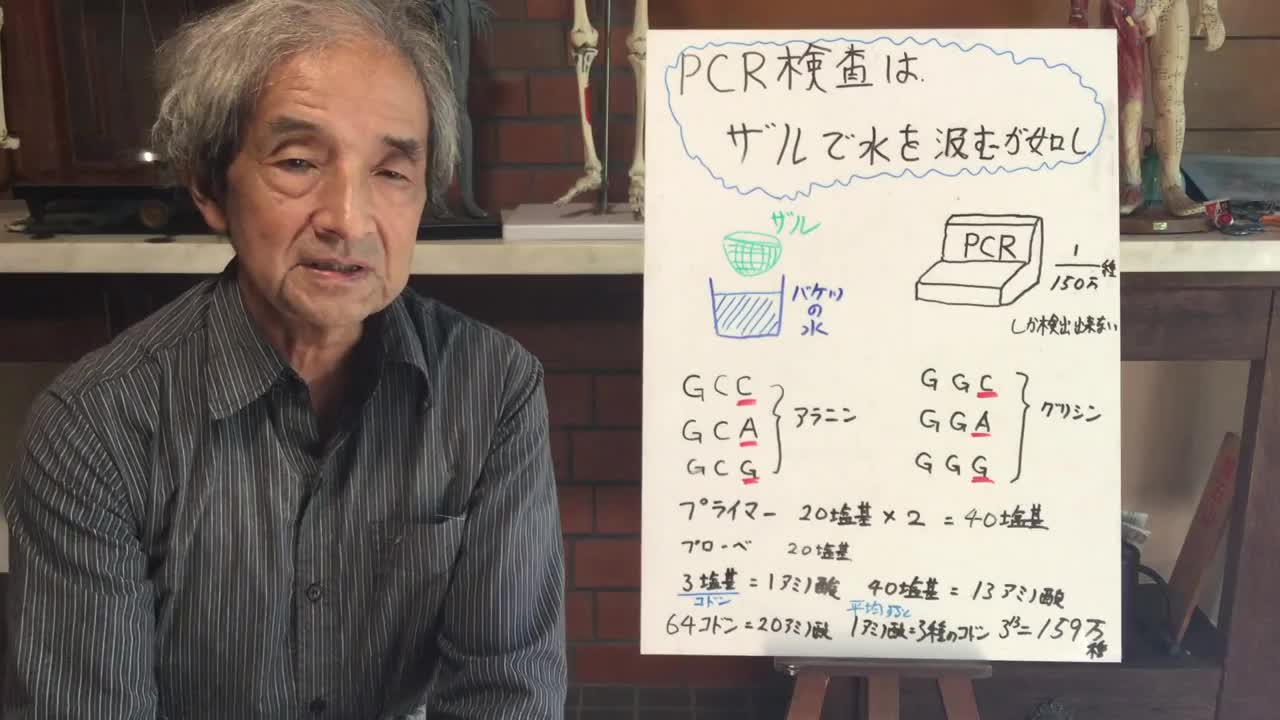Premium Only Content

【132】PCR検査では、このウイルス対策は不可能である - 大橋眞
現在問題となっているウイルス対策として、PCR検査の充実が行われようとしています。しかし、PCR検査が、このウイルス対策に適切なのかという議論はあまりされていません。PCRの発明者で、ノーベル化学賞受賞者のキャリーマリスが、「PCRは、感染症の診断に使ってはならない」という趣旨の言葉を残しています。この発言の意味について、これまで詳細に検討されたことはありません。今回は、この言葉の意味を分かりやすい例をもとに解説します。
RNAウイルスが、変異が多いことで知られています。RNAの複製機構には、複製の誤りを修正する機能がないことから、DNAの複製に比べるとはるかに遺伝子変異が多くなります。ウイルスの形質を決めるタンパク質の構造は、遺伝子から情報を得ています。遺伝子の情報は、塩基3つを単位(コドン)として一つのアミノ酸を決定しています。1つのアミノ酸を決定するコドンは、平均すると3種類あります。すなわち、1つのアミノ酸に対してコドンは3種類の可能性があるわけです。PCR検査では、プライマーという短い遺伝子2本を使って、遺伝子を増幅します。1つのプライマーはおよそ20塩基ほどの長さですから、2つのプライマーで40塩基になります。40塩基は13のアミノ酸に対応するコドンの情報を持っているわけです。一つのアミノ酸あたり3種類のコドンの可能性があるので、13アミノ酸では、3の13乗通り、すなわち約150万通りの遺伝子構造の可能性があるわけです。しかし、厳密にプライマーと目標の遺伝子との結合をおこなわせるようにPCRの反応条件を設定すると、PCRで検出できるのは、150万通りの遺伝子の中でただ1種類だけになります。今回問題となっているRNAウイルスの変異がどの程度存在するかは、不明です。感染研マニュアルの遺伝子シークエンスをするタイプのPCRでは、中国論文と95%程度以上の類似性を陽性限界にしています。このマニュアルが作成されたのは3月ですから、この時点で遺伝子変異がかなり進んでいることを示しています。すなわちPCR検査では、現在検出できない変異体が多数存在していることになります。そのために、変異体の調査をしないままに、PCR検査をいくら行っても、感染拡大の防止策にならないことは明らかです。そのために、PCR検査の充実は意味がないばかりでなく、もしこのウイルスが危険だというのなら、至急PCRに代わる検査法の確立しないと、感染拡大を防げません。PCR検査の問題点を認識しないと、大変なことになるのです。すなわち、PCR検査では、ウイルス対策は出来ないのです。遺伝子変異の実態調査のないPCR検査は、病原体ウイルス検査としての医学的意味はありません。キャリーマリスの言葉を重く受け止めないといけないのです。
As a countermeasure against viruses, which is currently a problem, PCR tests are being enhanced. However, there is not much debate about whether PCR testing is appropriate for this antivirus measure. Carrie Maris, the inventor of PCR and the winner of the Nobel Prize in Chemistry, has left the statement that "PCR should not be used in the diagnosis of infectious diseases." The meaning of this statement has never been examined in detail. This time, I will explain the meaning of this word based on an easy-to-understand example.
RNA virus is known to have many mutations. Since the RNA replication mechanism does not have the ability to correct replication errors, it has far more gene mutations than DNA replication. The structure of proteins that determine the traits of viruses is derived from genes. Gene information determines one amino acid with three bases as a unit (codon). On average, there are three types of codons that determine an amino acid. That is, there are three possible codons for one amino acid. PCR tests use two short genes, called primers, to amplify a gene. One primer is about 20 bases long, so two primers make 40 bases. 40 bases have codon information corresponding to 13 amino acids. Since there are 3 types of codons per amino acid, 13 amino acids have 3 to the 13th power, that is, about 1.5 million gene structures. However, if the PCR reaction conditions are set so that the primer and the target gene are strictly bound, only one of the 1.5 million genes can be detected by PCR. It is unknown to what extent the RNA virus mutation in question exists. In the PCR of the type of gene sequencing in the Infectious Diseases Research Institute manual, the positive limit is about 95% or more similar to the Chinese paper. This manual was created in March, indicating that gene mutations are quite advanced at this point. In other words, there are many mutants that cannot be detected by PCR tests at present. Therefore, it is clear that no amount of PCR testing can be done without investigating the mutants to prevent the spread of the infection. Therefore, not only is it meaningless to improve PCR tests, but if this virus is dangerous, the spread of infection cannot be prevented unless a test method that replaces PCR is established immediately. If you don't recognize the problems of PCR testing, it will be a big deal. In other words, PCR tests cannot take antivirus measures. A PCR test without a fact-finding survey of gene mutations has no medical significance as a pathogen virus test. We have to take Kary Mullis' words very seriously.
-
 33:14
33:14
Bek Lover Podcast
11 hours agoMark Zuckerberg Folds, Trump Talks World Domination & More Strange News..
1.79K7 -
 50:05
50:05
PMG
1 day ago"Hannah Faulkner and Dr. Carol Swain | THE GAY AFFAIR"
2.15K -
 9:35:23
9:35:23
MyronGainesX
15 hours agoElon Musk Censors Me, Alex Jones Stays Silent & Tate Runs For PM!
99.2K75 -
 2:57:43
2:57:43
Price of Reason
15 hours agoMark Zuckerberg REVERSES Course On Free Speech After Trump Win! Disney DESPERATE To Save Star Wars!
73.7K12 -
 5:03:05
5:03:05
JdaDelete
22 hours ago $9.23 earnedThe Legend of Zelda: Skyward Sword HD | With SirPoopsMagee | Part 2
78.1K4 -
 2:57:41
2:57:41
Laura Loomer
12 hours agoEP91: BIG TECH BILLIONAIRE TAKEOVER: Will MAGA Get the Justice We Deserve?
108K143 -
 1:11:49
1:11:49
Man in America
17 hours agoWhat They're HIDING About Europe's RAPE CRISIS Will SHOCK You
65.2K119 -
 5:41:33
5:41:33
The Sufari Hub
12 hours agoUPGRADING OUR GEAR : Fallout 4 : BEATING MAIN STORY FOR THE FIRST TIME!
38.7K -
 1:04:50
1:04:50
PMG
20 hours ago $12.23 earnedTraditional Southern Values Ain't Dead Yet w/ Stacy Lyn Harris
87.1K1 -
 1:26:43
1:26:43
Kim Iversen
15 hours agoHOLY SH*T! Zuckerberg DROPS CENSORSHIP Policy—Is Free Speech BACK? | Trump’s AMBITIOUS Move to Claim Greenland, Panama Canal & Canada
103K253